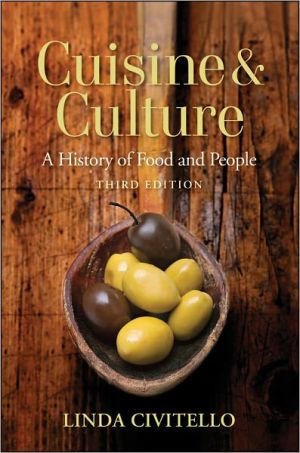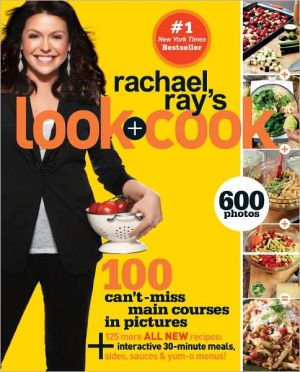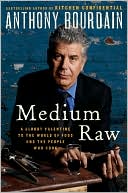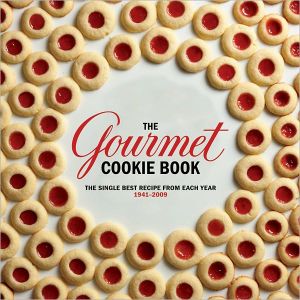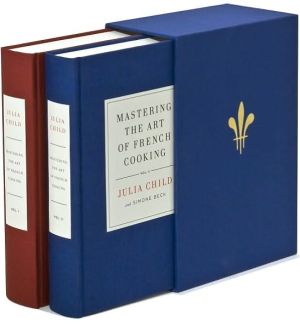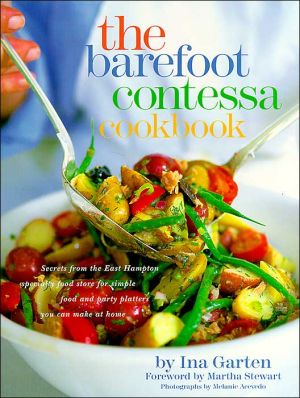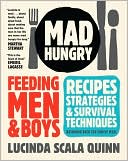Cuisine and Culture: A History of Food and People
From prehistory and the earliest societies around the Tigris and Euphrates Rivers to today's celebrity chefs, Cuisine and Culture, Second Edition presents a multicultural and multiethnic approach that draws connections between major historical events and how and why these events affected and defined the culinary traditions of different societies. Fully revised and updated, this Second Edition offers new and expanded features and coverage, including: New Crossing Cultures sections providing...
Search in google:
An illuminating account of how history shapes our diets—now revised and updated Why did the ancient Romans believe cinnamon grew in swamps guarded by giant killer bats? How did the African cultures imported by slavery influence cooking in the American South? What does the 700-seat McDonald's in Beijing serve in the age of globalization? With the answers to these and many more such questions, Cuisine and Culture, Second Edition presentsan engaging, informative, and witty narrative of the interactions among history, culture, and food. From prehistory and the earliest societies around the Tigris and Euphrates Rivers to today's celebrity chefs, Cuisine and Culture, Second Edition presents a multicultural and multiethnic approach that draws connections between major historical events and how and why these events affected and defined the culinary traditions of different societies. Fully revised and updated, this Second Edition offers new and expanded features and coverage, including:New Crossing Cultures sections providing brief sketches of foods and food customs moving between culturesMore holiday histories, food fables, and food chronologiesDiscussions of food in the Byzantine, Portuguese, Turkish/Ottoman, and Austro-Hungarian empiresGreater coverage of the scientific genetic modification of food, from Mendel in the 19th century to the contemporary GM vs. organic food debateSpeculation on the future of foodAnd much more! Complete with sample recipes and menus, as well as revealing photographs and illustrations, Cuisine and Culture, Second Edition is the essential survey history for students of food history.
\ Cuisine and Culture\ \ \ A History of Food & People\ \ \ \ By Linda Civitello\ \ \ John Wiley & Sons\ \ \ \ Copyright © 2003\ \ Linda Civitello\ All right reserved.\ \ \ ISBN: 0-471-20280-0\ \ \ \ \ Chapter One\ \ \ Sixth Course\ \ Thanksgiving, Hutsepot,\ and Haute Cuisine:\ 17th-Century America,\ the Netherlands, Russia, France\ \ COLONIAL AMERICA\ The Chesapeake: The Starving Time\ England's colonies in North America did not get off to a good\ start. After one, Roanoke, completely disappeared (historians still don't\ know what happened to it), British settlers came to Chesapeake Bay in\ 1607. They named the colony Virginia in honor of Elizabeth I, the Virgin\ Queen; they called the capital Jamestown after King James; and\ they expected to get rich quick-except that the natives refused to be\ their slaves. In the winter of 1609-10, when not enough food had\ been grown, harvested, or preserved, almost all five hundred colonists\ died during what became known as "the starving time." Captain John\ Smith later wrote what he had heard about how the colonists were\ reduced to eating nuts, berries, acorns, horsehide, and worse:\ And one amongst the rest did kill his wife, powdered [salted]\ her, and had eaten part of her before it wasknown, for which\ he was executed, as he well deserved. Now whether she was\ better roasted, boiled, or carbonadoed [broiled], I know not; but\ of such a dish as powdered wife I never heard of.\ It was not the last time cannibalism would be resorted to in America.\ Later Virginians wanted to grow a profitable crop; they tried sugar\ but the climate was too cold. They settled on tobacco. Soon tobacco\ was bringing in so much money that people planted it on any available\ land-they ripped up their gardens, even grew it between graves. But\ who would hoe and harvest these thousands of acres of tobacco? The\ Native Americans who didn't die of Old World diseases refused to do\ it. African slaves were too expensive, although some arrived in 1619.\ England had the perfect labor force: a surplus of poor, desperate young\ men in their late teens and early twenties. They signed an indenture-a\ contract-giving them a free trip to America and free room and\ board in exchange for four to six years of work. Then they were supposed\ to get their freedom, tools, corn, and land of their own-something\ they had zero chance of getting in England. The person who\ hired the indentured servant and paid for his trip received free labor\ and fifty acres of land. It was a sweetheart deal all around. Except ...\ Most of these young men didn't live four years after they got to\ America. They died from dysentery, typhoid, malaria. The ones who\ did live found that there was only one woman for every six men. And\ soon the best land was in huge plantations owned by a few wealthy\ men who also had all the political power. In 1676, when former indentured\ servants couldn't get land, women, or the vote, they went on a\ rampage. Bacon's Rebellion ended with Jamestown burned and more\ than 20 former indentured servants hanged. Planters wanted a labor\ force they could control, not these Englishmen who used violence to\ get their rights. In 1698, when England ended the Royal African Company's\ monopoly on the slave trade, anyone with a ship could get into\ the slave trade. With competition, the price of slaves dropped. Now it\ was affordable to own Africans and profitable to sell them.\ \ The Carolinas and Rice\ At about the same time, the English established a colony south of\ Virginia-Carolina, named after King Charles II. Many of the settlers\ were from Barbados. They intended to grow food for the Caribbean\ sugar plantations and to export more expensive items, but after failing\ at wine, olive oil, and silk, they decided on rice as their staple crop.\ Rice requires skilled labor; Africans had this skill. They were also\ immune to malaria, and weren't Christian, so according to the Christian\ world at that time, they could be enslaved for the rest of their lives.\ The settlers also imported the Barbados slave code, with punishments\ that escalated from whipping to facial mutilation and sometimes\ death, which the code said was the slave's fault for forcing his master\ to discipline him. Charleston, South Carolina, became the primary\ port through which slaves entered the United States. By 1710, black\ slaves outnumbered white settlers in the coastal regions of the area\ that became South Carolina.\ In spite of the conditions under which the slaves were brought to\ America, some of their African cuisine and culture survived. This influenced\ how cooking developed in the American South, since they were\ the cooks. Along with their knowledge of rice cultivation, cooking, and\ storage, they brought yams, okra, watermelon, and their love of fried\ food. They also brought back foodstuffs that had been taken from the\ New World to Africa, like the chile pepper and the peanut, and their\ word for it-goober. They brought the banjo and the drum and the\ music that would become jazz.\ \ New England: "Almost Beyond Believing"\ In 1620, Pilgrims-Protestants who wanted to be allowed to worship\ without being persecuted-landed at Plymouth, Massachusetts.\ Before they went ashore, the men on the ship entered into an agreement.\ The Mayflower Compact was the first constitution in America.\ Only one paragraph long, it sets forth an important principle: that all\ would be equal and work together as a community.\ The Pilgrims, and the Puritans who settled the Massachusetts Bay\ Colony in Boston ten years later, had their work cut out for them.\ These were people used to living in towns. They didn't know how to\ hunt or fish or farm. But they didn't like many of the strange plants\ and animals in North America anyway-those huge quahog clams, the\ slimy steamers. And the codfish and lobsters were bigger than they\ were, sometimes six feet long. They wouldn't eat them at first, even\ after the Indians showed them how. But with the help of the native\ tribes, the Pilgrims survived their first year and had a celebration.\ \ Thanksgiving Foods\ "The turkey is certainly one of the most delightful presents\ which the New World has made to the Old."\ -Brillat-Savarin\ \ Most of the foods Americans eat at Thanksgiving dinner now are\ native to the Americas: turkey, cranberry sauce, mashed potatoes,\ sweet potatoes, corn-bread stuffing, pumpkin pie. In French the word\ for turkey is dinde, short for poulet d'inde, which means "chicken from\ India," because the French, like other Europeans, thought the turkey\ was from the Indies. Geese, ducks, and other wild fowl were abundant\ only during certain seasons in the New World, but turkeys don't\ migrate, so they were available all year. And they had an instinct that\ helped humans: when one turkey was shot, the others froze in place.\ It was easy to kill a dozen turkeys in a morning. Nobody ever called\ anybody a turkey and meant it as a compliment.\ Cranberries and blueberries, both members of the heather family\ and both native to New England, were more than food in sauce and\ pies. Mashed and mixed with sour milk, they were used as paint. That\ is why the colors most often associated with colonial American buildings\ are muted cranberry and milky purple-gray.\ Although pumpkin was widely used in the colonies, recipes for\ pumpkin pie didn't appear in print until the first American cookbook,\ written by Amelia Simmons in 1796. She called it "pompkin" and gave\ two different versions. Both had pumpkin, ginger, and eggs, but one\ used cream and sugar, the other milk and molasses. One used the Old\ World spices mace and nutmeg, the other New World allspice.\ \ The Codfish\ The staple "crop" in the Massachusetts Bay Colony was the codfish,\ Gadus morhua. What sugar was to the Caribbean and tobacco was to the\ Chesapeake, cod was to Massachusetts. There were millions off the\ coast, north to Newfoundland and Labrador. Once it was salted and\ dried, cod was stiff as a board and could be stacked and shipped like\ lumber. It was also almost 80 percent protein. In this form it made its\ way to Europe: bacala in Italy, bacalao in Spain, bacalhau in Portugal.\ According to historian Mark Kurlansky, by the middle of the 16th century,\ "60 percent of all fish eaten in Europe was cod." It was the perfect\ food for Lent. The best grade was sent to Spain; the worst fed the slaves\ in the West Indies. It could also be bartered for slaves in Africa. Ship-builders\ got rich because of cod, too. The cod was so important to the\ economy of Massachusetts that a large carved wooden cod hangs in the\ statehouse in Boston. See page 132 for an example of what it looks like.\ \ Maple Syrup: Tapping the Sap of the Sugar Tree\ "Maple Moon" was what Native Americans called the time in the\ spring when the sap started to flow in the sugar maple tree, Acer saccharum.\ Just as the grapevine was a symbol of resurrection for the\ ancient Greeks, so the maple was for Native Americans. Flowing sap\ meant the end of winter and the rebirth of nature. The Iroquois performed\ a religious ritual, a maple dance, to pray for warm weather and\ plenty of sap. According to legend, an Iroquois chief pulled his tomahawk\ out of a tree where he had thrown it the night before and went\ off to hunt. In the meantime, the weather turned warm and sap oozed\ into a container left by accident at the base of the tree. On her way to\ get water for cooking, his wife saw the container of liquid and used\ that instead; everyone agreed it was much better than water.\ Seventeenth-century European writers give Native Americans full\ credit for knowing how to make maple syrup and sugar, but in the\ 18th century, Europeans started to claim that they taught the Indians.\ As historians Helen and Scott Nearing have pointed out, language is\ on the side of the tribes. All their words for maple syrup translate as\ "drawn from wood," "sap flows fast," "our own tree," while they called\ white sugar "French snow"-a clear indication of its origin.\ Maple sugar was a primary food in Native American cooking;\ among some tribes it was the only condiment. It replaced salt, which\ they did not like, and it was used to season dried cornmeal porridge,\ mixed with bear fat as a sauce for roasted venison, sprinkled on boiled\ fish, and eaten with berries or all by itself, a pound a day.\ It was reconstituted into a sweet drink that was used in ceremonies, along\ with tobacco smoked in the peace pipe. Women boiled the sap from\ maple, walnut, hickory, box elder, butternut, birch, and sycamore trees\ down to sugar crystals, which was difficult because before Europeans\ came, they had no metal pots. Their vessels were made of birch bark\ or gourds which held between one and two gallons and could not be\ placed directly over fire. Instead, they dropped heated stones into the\ liquid until it boiled, which involved continuously taking out cool\ stones and replacing them with hot ones. These small amounts of liquid\ were then poured into hundred-gallon moose-skin vats. It is not\ surprising that the Indians began to trade for metal pots and utensils\ as soon as the Europeans introduced them. Another way to process\ the syrup was to let it freeze at night, then scrape the ice off the top.\ This required several nights until just syrup was left. Maple sugar that\ was to be used for gifts was poured into molds that one European\ described as shaped like "bear's paws, flowers, stars, small animals,\ and other figures, just like our gingerbread-bakers at fairs."\ \ The American Culinary Tradition: Pocket Soup and Johnnycake\ American cooking developed along two parallel lines. In the\ South, where slave labor did the kitchen work, cooking could take\ more time. Labor-intensive cooking, such as barbecue, could be done\ by slaves. Barbecue needed a great deal of preparation. Either beef or\ pork had to be properly butchered and marinated. Then the fire had\ to reach just the right temperature, and the meat had to be added. The\ fire had to be carefully watched and the temperature maintained. This\ required a great deal of labor. However, pit cooking developed differently\ in New England, in the form of the clambake. There, a fire was\ allowed to burn down in a pit; then clams, lobsters, and corn were\ buried under wet seaweed and left to steam for several hours. No labor\ was necessary to prepare the food before or after it was placed in the\ pit, except to dig it out.\ American cooking in the North arose from the middle-class necessity\ of doing a great deal of work as quickly as possible. They invented\ shortcuts and new ways to preserve foods. Two examples are pocket\ soup and johnnycake. Travel was not easy in the colonies. Roads were\ poor or nonexistent, and there was no guarantee that travelers would\ be able to find food when they needed it. Sailors, too, appreciated a bit\ of home. Pocket soup, also known as portable soup, was the solution.\ This was an early bouillon cube-soup cooked down until it was a\ condensed gelatinous mass, then cut into small cubes and dried for\ ten days. Dropped into a cup of water, it reconstituted into soup. Johnnycake\ or journey cake was a cornmeal cake that would keep without\ becoming moldy or disintegrating.\ Another example of New England fast food was hasty pudding,\ made famous in the song "Yankee Doodle" (and in the name of a Harvard\ University club). This was cornmeal-called Indian or "Injun"\ meal-or rye meal cooked on top of the stove, not baked, so it was\ ready in half an hour. This is a long time by today's microwave standards,\ but the baking times for regular cornmeal pudding recipes in\ American Cookery range from one and a half hours to two and a half\ hours. Sara Josepha Hale's recipes for cornmeal pudding require three\ to four hours of cooking, even those that are boiled. What makes hasty\ pudding hasty is that the meal is soaked first and added a bit at a time,\ and the pudding is boiled and stirred constantly. In this cooking technique,\ it resembles polenta.\ \ Cobbler, Slump, Grunt, Dumpling, Crumble, and Crisp\ Just as regional cooking developed according to the kind of produce\ and labor available in each area, different areas had different\ names for the same food. For example, in most of the country, a cobbler\ is chopped, sweetened fruit with a sweet biscuit dough baked on\ top. The exception is New England, where it is called a slump, with the\ further exception of Cape Cod, where it is called a grunt. Other combinations\ of fruit and dough are a dumpling, pieces of fruit or a whole\ fruit, like an apple, wrapped in a pastry square and baked. A crumble\ is a mixture of flour, butter, sugar, and seasonings like cinnamon and\ nutmeg crumbled over chopped fruit and then baked. A crumble is different\ from a crisp because a crisp has more butter, which makes the\ topping ... crisper. The topping on a crisp sometimes includes oats.\ \ Continues...\ \ \ \ \ \ \ Excerpted from Cuisine and Culture\ by Linda Civitello\ Copyright © 2003 by Linda Civitello.\ Excerpted by permission.\ All rights reserved. No part of this excerpt may be reproduced or reprinted without permission in writing from the publisher.\ Excerpts are provided by Dial-A-Book Inc. solely for the personal use of visitors to this web site.\ \
Antipasto/Antojitos/Amuse-BouchesA Note About Reading HistoryAcknowledgmentsFirst CourseFrom Raw to Cooked: Prehistory, Mesopotamia, Egypt, China, IndiaSecond CourseThe Goddess of Grain and the God of the Grape: Ancient Greece and Imperial RomeThird CourseCrazy Bread and Courtly Manners: The Middle Ages, 500-1300Fourth CourseTea, Chocolate, and the Printing Press: Asia, the Americas, and the First Cookbook, 1300-1500Fifth CourseThe Columbian Exchange: The 16th CenturySixth CourseThanksgiving, Hutsepot, and Haute Cuisine: 17th-Century America, the Netherlands, Russia, FranceSeventh CourseElection Cake and "Let Them Eat Cake": The American and French RevolutionsEighth CourseFrom Coyotes to Coca-Cola: The 19th Century in AmericaNinth CourseSanitation, Nutrition, Migration: The 19th Century in Europe, Asia, and AfricaTenth CourseThe Purity Crusade, Cuisine Classique, Communal Food, and Prohibition: The Early 20th Century in the United States, Europe, and RussiaEleventh CourseSoup Kitchens, C-Rations, and TV Dinners: The Depression, World War II, and the Cold WarTwelfth CourseRevolutions in Cuisines and Cultures: The 1960s Through the Next MilleniumApp. AFrench Pronunciation319App. BItalian Pronunciation321App. CCookbook and Food Books Chronology323Notes329Bibliography341Index355
